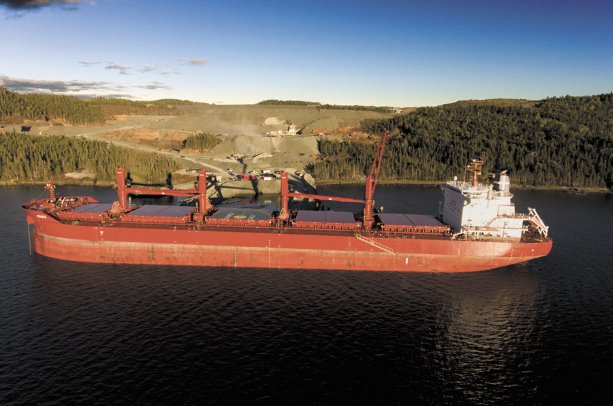Anaconda Mining started 2016 as a profitable gold miner, actively producing around 16,000 ounces of the precious metal annually at its Point Rousse, N.L. site and finished it with a lucrative new sideline already up and operating as an international exporter of aggregate.
But as Anaconda general manager Allan Cramm tells it, the whole export plan, which involved a $10-million investment to build an access road and conveyor system to load crushed waste aggregate onto a ship bound for South Carolina, could have been derailed, or more likely significantly delayed, by a possible Canadian Environmental Assessment Act (CEAA) review that first loomed after the new venture was already in full operation.
The mine was launched in 2008 and Cramm said over the years he and his colleagues regularly wondered whether there could be better use for the waste aggregate — 10 million tonnes of it slated to be created over the 10-year life of the mine — than simply stockpiling it on site.
"In 2015, I said, ‘we’ve got to have another look at this, we just can’t accept this,’ " Cramm said.
So Anaconda had the waste rock, mostly volcanic gabbro, tested and found it was essentially clean of the acids, arsenic, mercury and oxidizing impurities that often contaminate waste and make it unsuitable for other uses.
That December he got the call he wanted. An agent said he had found a project in Charleston, S.C. looking for rock fill to weigh down dredged riverbed where a new container system was being built. The rock would compact the soil with moisture removed through wicks. It’s a fascinating project in its own right, Cramm said.
Everything — almost — fell into place quickly. Cramm contacted a local contractor, Guy J. Bailey Ltd. from nearby Baie Verte, headed up by a second-generation constructor, Scott Bailey, whom Cramm had known since their school days over 30 years ago.
The shipping partners lined up were Shore Line Aggregates, a subsidiary of Bailey, and Phoenix Bulk Carriers. The deal was, for 14 months the partners would supply 3.5-million tonnes of aggregate to the South Carolina client.
The build was done in three months and shipping started in September with one 60,000-tonne shipment a week. By December, Anaconda was able to announce it had shipped one-million tonnes of aggregate.
That Dec. 22 statement also reported other welcome news that the Canadian Environmental Assessment Agency had decided, three months after the build was done, that no further environmental assessment was needed.
Cramm said Anaconda first heard that the agency might determine a project assessment was called for around late August.
The brief subsequently submitted to the CEAA offered an explanation for the oversight, indicating among other points that Anaconda had proceeded based on a legal opinion that the approvals it had already obtained at local and provincial levels were all it needed.
All was done in good faith, said Cramm, but still they were on pins and needles until they received word no assessment would be required.
"It could have been a big problem," he said.
CEAA communications advisor Nicolas Latourelle explained the decision: "The agency is satisfied that the potential adverse environmental effects on matters within federal jurisdiction…can be adequately addressed through the mitigation measures proposed by the proponent, and the federal and provincial regulatory processes."
Meanwhile, Cramm said the export of its waste aggregate has resulted in a major shift in the mine’s fundamentals. The operation can now be considered to have minimal environmental impact, he said, and Anaconda’s balance sheet has also been significantly altered.
Consider haulage alone, said Cramm: "Each shipload that goes from here is the equivalent of 2,200 tractor trailer loads."
"The barge was an innovative idea, because it was fast and it minimized any kind of environmental impacts," he said. "When we are done here and if we are not successful in getting a future project, we just move the barge."
Anaconda is now looking to ship out all of the waste aggregate to other potential clients and it’s also looking for markets for the waste from several other potential local mines currently in various stages of development. Even the 10-year life of the Port Rousse mine itself could be re-evaluated, he said.
When the mine is depleted, Cramm said — the refined product is refined onsite in the Pine Cove Mill and sent in gold bars via a Brink’s truck to the Royal Canadian Mint — and if all 10-million tonnes of waste aggregate are sold, that leaves a void in the open pit that could store a similar amount of waste rock from the other mines that Anaconda may develop.
There is even a plan being spawned to develop a soil-stabilization grout with the tailings that could be sold as a cement.
And even longer term, Cramm talks about opportunities created by the opening of the Northwest Passage. He also imagines all the deltas requiring shoring where Anaconda’s clean waste rock could be delivered harbour to harbour with no trucking needed.
"I have coined a phrase, this is the aqua project, because that is what you get when you combine gold and green," said Cramm. "Because it is that kind of initiative. We thought we could be the first totally green mine in Canada, where when this mine is finished, there will be absolutely zero environmental impact. No tailings, no waste rock left around the site, the entire site would be left the way it was before we started."




Recent Comments
comments for this post are closed